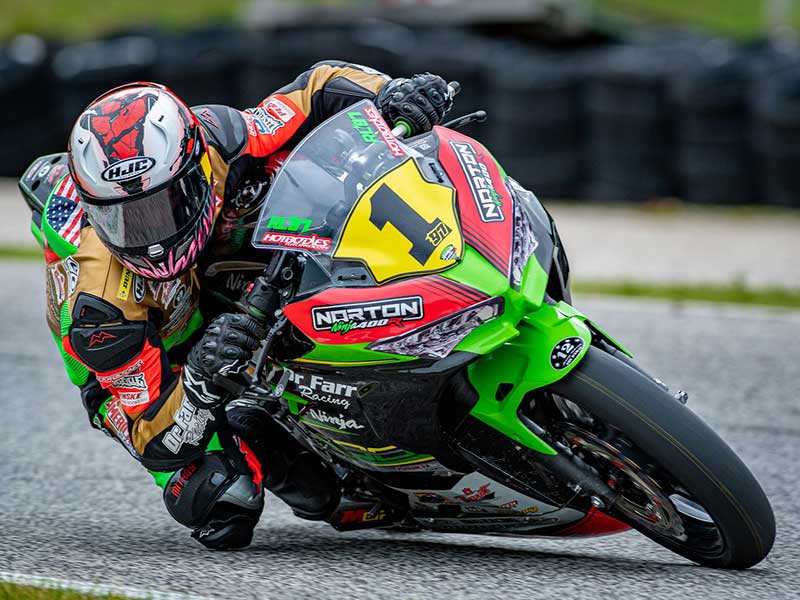An Introduction to Motorcycle Suspension Tuning

June 7, 2021

Tuning a motorcycle's suspension is one of the most critical ways to get the most out of it. Not only will it make a more comfortable ride, it will be tailored to your specific wants, needs, and riding style, while also making your ride safer.
The good news is that you don't need to be an expert mechanic to dial in your motorcycle's suspension – it just comes down to having the knowledge.
Why tune your motorcycle suspension?
But first, why should you dial in your motorcycle's suspension? Let's dig into the why and then the how.
No one setting fits all
Tailoring your motorcycle to your liking and personal needs from the start is the way to have a much better riding experience. Motorcycles on the showroom floor with OEM suspension are made to fit everyone, and that can’t be done. There is, unfortunately, no magical setting that will work for every rider in every situation.
Your body will thank you
A bike with a good suspension set up to get you the most performance will provide better handling, giving you a more comfortable and safer ride, ultimately making the whole experience better. Riding a motorcycle is a physically draining task where you can feel every imperfection on the road. However, having a custom suspension setup can change the game and allow you to ride longer and more comfortably. Ride lengths can be extended from 100 miles to around 500 miles with a proper suspension setup - talk about a good return on your time!
Prevent wheelspin
Having a properly tuned suspension can also prevent wheelspin. Most motorcycles produce enough power that can cause the rear tire to spin on acceleration.
If springs are too soft, the suspension can bottom out, with all the force pushed to the rear tire, which can flex because it is a rubber carcass. When that tire is pushed beyond its limit, you end up with wheelspin. Conversely, it can happen with springs that are too stiff, as the suspension cannot move, and the acceleration force is again pushed directly to the tire.
Get Started
Before you pick up a tool to make any sort of adjustment, you need to think about all of the aspects of how you ride so that you are making tuning updates that actually fit your needs.
Many factors all play a part in finding your optimal settings. You should consider how you will ride for the majority of the time and adjust your settings accordingly.
Some items to consider are:
- Your riding style
- If you will be riding two-up for the majority of the time
- Your tires
- Where you will ride most often (city vs. country vs. track)
- The weight of the bike, your gear, and your rider(s)
- Your bike accessories
- If you will be towing
Setting your sag
Now that you have considered your ultimate goal, the starting point for tuning your motorcycle's suspension is setting the sag, especially if you have a street bike. The sag is how much the motorcycle settles when you are on the bike. Determining and setting sag on your motorcycle is a simple process. All you need is a tape measure and a rider in full gear.
PRO TIP: Always write down your current setting(s) before making any changes. This allows you to back off any changes to their previous state should you deem that necessary.
Step 1: Starting with the front, measure the suspension fully extended with the front wheel off the ground, measure the lower fork legs exposed portion, write the number down, and mark it as L1.
Step 2: Then push the front of the bike down and let it rise back up and measure the fork leg again, and label it as L2.
Step 3: The third step is the opposite of step 2 – lift the front of the bike and let it settle before measuring the fork and mark it as L3.
Step 4: Calculating the sag figures is a simple math equation – add the L2 and L3 figures and subtract from L1 before dividing by 2 - L1-(L2-L3)/2.
Step 5: The only difference in measuring the rear suspension is there are no forks to measure, so you will need to measure from the axle to a fixed point on the tail. However, the process is similar – measure off the ground, push down and lift up, and calculate using the equation.
The ideal number for sag should be:
- For racetrack, 30 - 35 millimeters for the front and within 25 - 30 millimeters in the back.
- For street, 35 - 45 millimeters for the front and 30 - 35 millimeters in the back.
Adjustments can be made according to the specifications of the motorcycle.
If you can't get your sag right after adjusting it – that is a good indication that your spring rates are off. If you have maximized preload and have too much sag – that is a sign that you need stiffer springs. If you have taken all the preload out and still have too much – your springs are too stiff.
FREE WEBINAR - Motorcycle Suspension: Spring Basics
In this on-demand webinar, we will do a live demonstration with a bike and rider and take you through some of the basics of managing your spring setup. This webinar will help you make sense of each adjustment, and how they will affect the feel and performance of your suspension.
Improve both ends for balance
Having the proper setups on both ends of the bike is another essential factor to consider in tuning your bike. Stability is a vital factor in how the motorcycle turns and maneuvers.
If you are new to putting performance shocks on your bike, it can be tricky to understand what end needs the most work, and only making one side better will bring out the worst of the other end.
For example, a high rear bike can oversteer and make the ride very twitchy while cornering, and being too high in the front causes understeer, making the bike push while cornering.
Checking your sag is the right place to start when balancing your ride. Too little sag often points to needing a softer spring, while too much sag indicates that the spring needs to be stiffer.
Hydraulic preload adjusters make for easy adjustments
Hydraulic preload adjusters allow for easy and quick adjustments to your suspension. Preload, in a nutshell, is how much the spring is physically compressed from free length with the spring fully extended. It is harder to compress a spring when it is already compressed, so preload allows the spring to take more force.
It is typically adjusted with a preload adjuster wrench, but a hydraulic preload adjuster makes for a simple task. It works by turning a knob that forces oil from a master cylinder to a slave cylinder, which loads the spring.
Hydraulic preload adjusters provide riders with quick access to change preload settings for changes in road conditions along with needed changes if extra weight is added to your bike, like an additional rider or luggage.
Ultimately, a dialed-in motorcycle suspension is a worthwhile investment to make your bike better. Setting up your suspension will make the ride safer, smoother, and ultimately more fun. For many riders, motorcycles are a luxury, and taking care of the suspension is one of the best ways to protect their asset. That peace of mind knowing that you’ve done the proper tuning, and did it yourself, will give you peace of mind for years to come as you put miles on your bike.
Let Our S3 Program Help
If you are struggling with the performance of the suspension on your bike, we can help. Optimizing suspension performance requires both the right hardware as well as a proper, customized setup. The Penske Racing Shocks S3 program is designed with this process in mind to help you be at your best, from the start.


%20(1).png?width=1080&height=1080&name=Heritage%20Cruiser%20Shock%20-%20IG%20(1)%20(1).png)